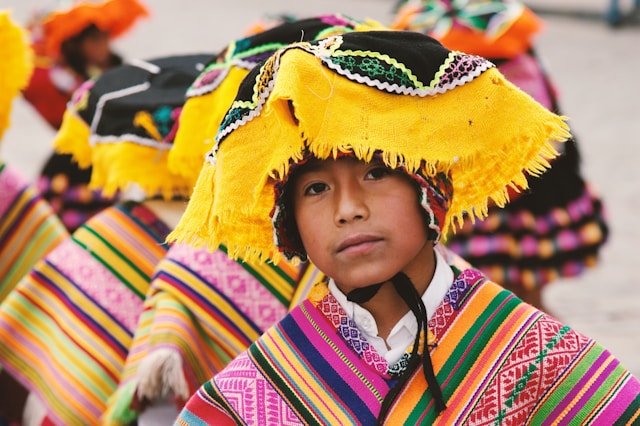What better time to visit Cusco, the ancient heart of the Inca Empire, than during the Inti Raymi festival?

Inti Raymi 2017 at Coricancha, Cusco’s Temple of the Sun. Photo by Everywhere Please.
Inti Raymi festival, the Inca ‘Cusco festival of the sun’, is celebrated during the winter solstice (June 24) and is one of the biggest festivals in South America.
Surely it is also the grandest, most colourful celebration of Inca culture that exists in modern times.
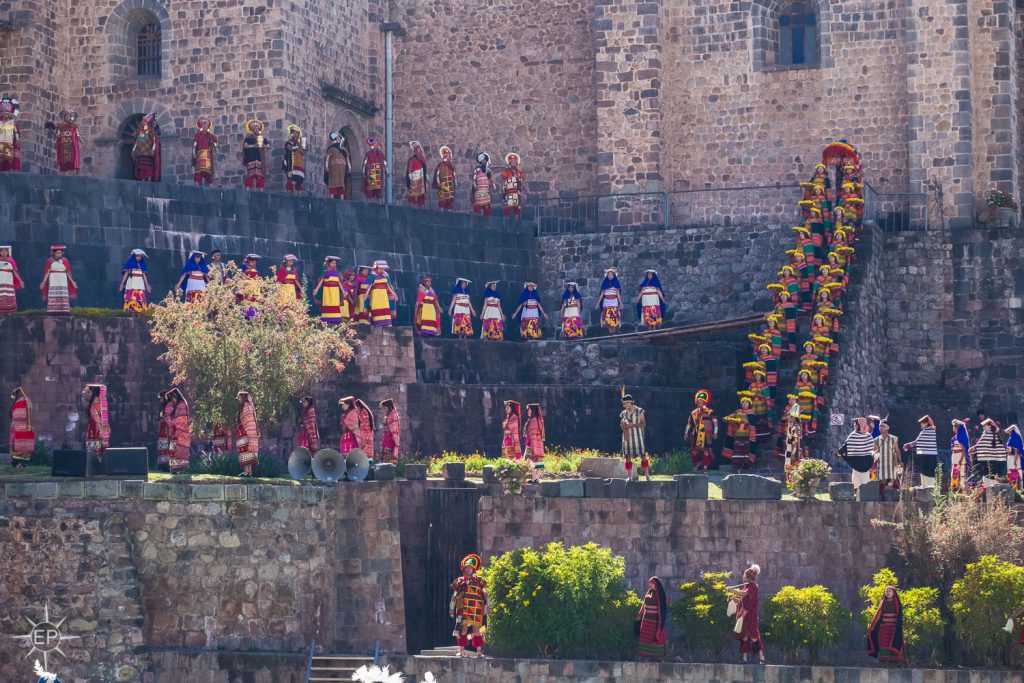
Inti Raymi kicks off at Qoricancha. Photo by Everywhere Please.
As early as two weeks before festival day, the city comes alive with excitement.
Groups of dancers and musicians perform traditional Andean music in the main square and parade through Cusco’s narrow, cobbled streets.
Nightly fireworks displays compete with the bright colours of the performers’ costumes and street vendors sell Incan festival dishes.
And that’s just the build-up to the main event: the Inca ceremony in the ancient fort of Sacsayhuaman!
Inti Raymi is a festival very much in line with the character of the city of Cusco.
Fascinating Features of Cusco festival of the Sun
First-time visitors to the city cannot fail to be struck by the unique blend of Incan and Colombian architecture.
Colonial-style buildings, with their elegantly carved balconies and archways, sit on top of foundations that have all the hallmarks of Inca engineering: giant boulders, carved with such precision as to render any kind of cement unnecessary.
Similarly, the city’s culture is a fascinating blend of Catholic and Andean traditions.
One of the biggest moments in the build-up to Inti Raymi, the Cusco festival of the sun, is the Catholic festival of Corpus Christi.
In Cusco, this religious day is celebrated with processions that actually have roots in Inca customs. The Spanish missionaries simply insisted that the Incas exchanged the mummies of their traditional parades for images of the Virgin and the saints!
History of the Inti Raymi festival or Cusco Festival of the Sun
Origins in the Inca Empire

In Inca Times
In Inca times, the Inti Raymi festival was a homage to the Sun god Inti. The Incas, as the children of the Sun, believed Inti to be their ancient ancestor and their source of life. The festival was held at the midwinter solstice, when the sun was furthest from the earth, as a plea to Inti to return to his Inca children and give life to their crops.
The Cusco festival of the sun also marked the start of the new year for the Incas, so the purpose of the festival was to secure Inti’s blessing for the upcoming year, and to give thanks for the sun’s life-giving heat and light.
Qoricancha – Cusco’s Temple of the Sun
To understand the importance of Inti, you need only visit Qoricancha (the Temple of the Sun) in Cusco. This temple was constructed by Inca Pachakuteq at the geographical centre of the ancient city of Cusco, establishing it as the religious centre of the city and one of the most important sites.
In Inca times, the solid gold plates that covered the walls of this fabulous temple shone like the sun itself; of course, these have long since been looted. However, you can still see this stunning building glowing golden at night.

Qoricancha, the Temple of the Sun in Cusco. Photo by Everywhere Please.
The original Inti Raymi festival
The original Inti Raymi festival was a rather more gory affair than the modern celebration.
The Sapa Inca, along with his nobles and chosen warriors, would fast for three days, and then paint their faces yellow and wear headdresses made from the heads of deer.
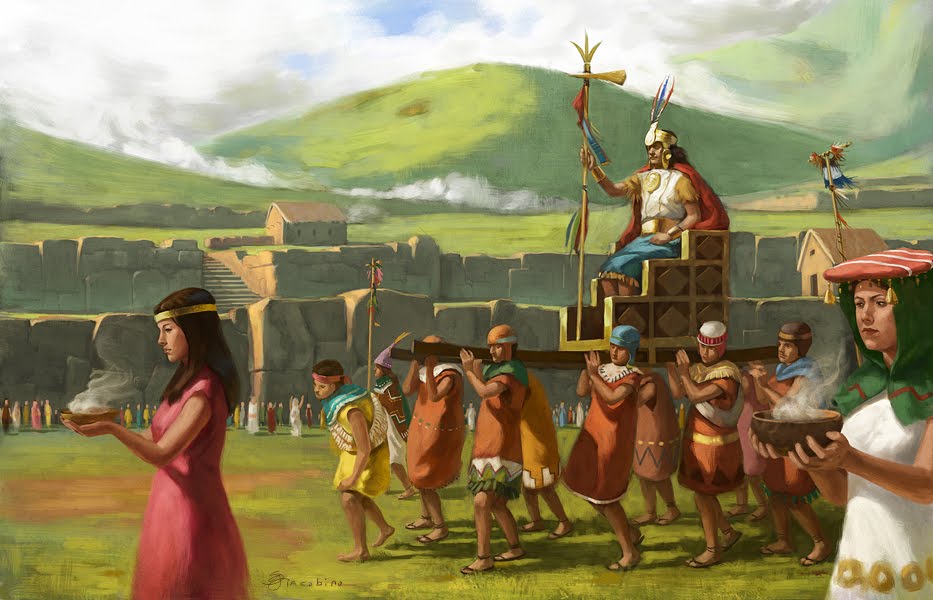
A depiction of Inti Raymi festival in ancient times.
The participants would drink toasts of chicha to Inti, and sacrifice black llamas to make auguries for the upcoming year.
Hauntingly, the traditional sacrifices also included young children, one from each of the four corners of the Empire.
Suppression and Rediscovery
The Inca Empire began to fall apart in the early 16th century. A smallpox epidemic brought to the Americas by the Spanish ravaged the population, wiping out the Sapa Inca and his heir and plunging the empire into civil war.
An army of conquistadors, led by the Pizarro brothers, invaded the Incan Empire in 1532. By 1533, they had executed the last emperor Atahualpa and established Cusco as the capital of the Spanish colony.
The Cusco festival of the sun, Inti Raymi, was banned by the Spanish conquistadores after the fall of the empire. The driving ideological force behind the Spanish empire building was the spreading of the Catholic faith. Therefore, such “pagan” festivals could not be permitted.
After the rebellion of the last Inca ruler, Tupac Amaru, all Inca traditions were strictly prohibited, and even traditional Inca clothing was not allowed.
Inti Raymi was lost to oblivion until 1944, when it was restored by Faustino Espinoza Navarro, founding member of the Peruvian Academy of the Quechua Language. Since the Incas had no system of writing, Espinoza based his impressions of the ceremony on the chronicles of Garcilaso de la Vega, a 17th-century poet who was the son of a Spanish conquistador and an Incan princess.
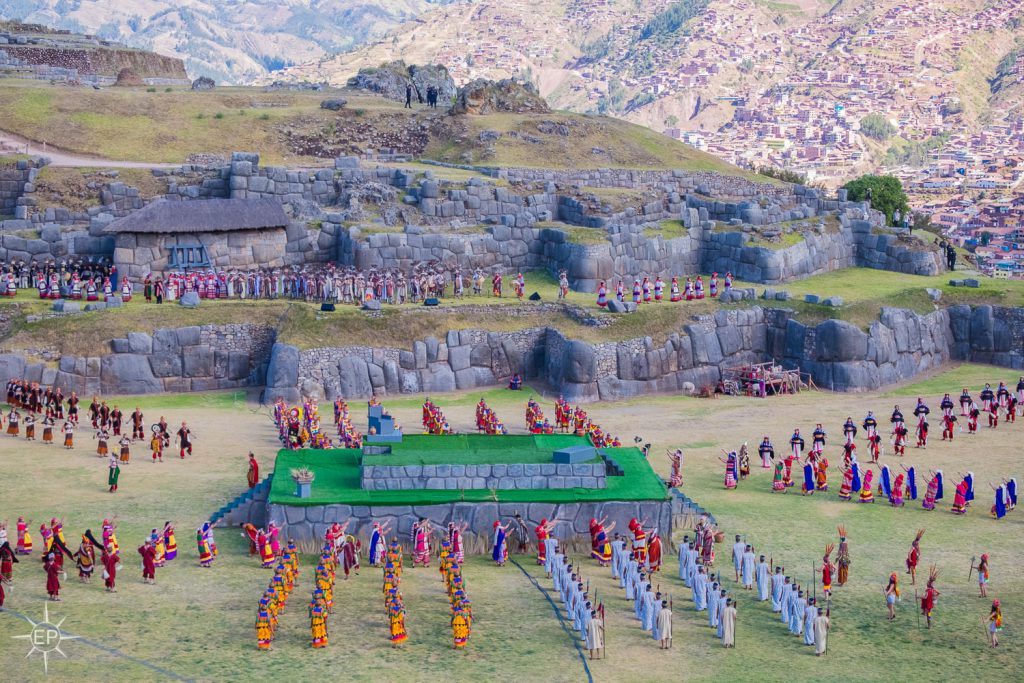
The festival has grown to include hundreds of performers. Photo by Everywhere Please.
The first modern Inti Raymi festival was celebrated with a cast of some 600 local actors, with Espinoza himself playing the part of the Sapa Inca.
Since then, the celebration has grown in both popularity and accuracy, with details being added from Quechua oral histories and contemporary chronicles of the conquest.
 How is the Inti Raymi festival celebrated today?
How is the Inti Raymi festival celebrated today?
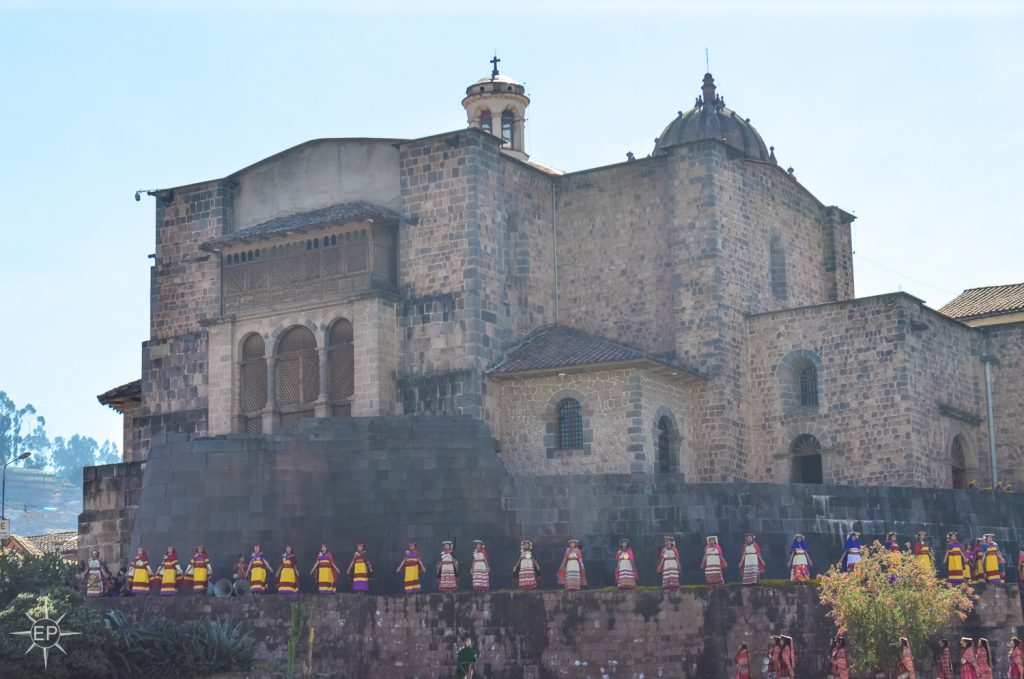
Celebrations begin at Qoricancha temple. Photo by Everywhere Please.
The modern Inti Raymi celebrates a new cycle of life, just like the original Inca festival.
Other similarities include the colourful clothing, the traditional music and the presence of thousands of visitors from outside the empire.
Cusco festival of the Sun-Inti Raymi begins at Qoricancha
The festival begins at 8am.
The Sapa Inca emerges from the Qoricancha, and is carried on a golden chariot to the Plaza de Armas.
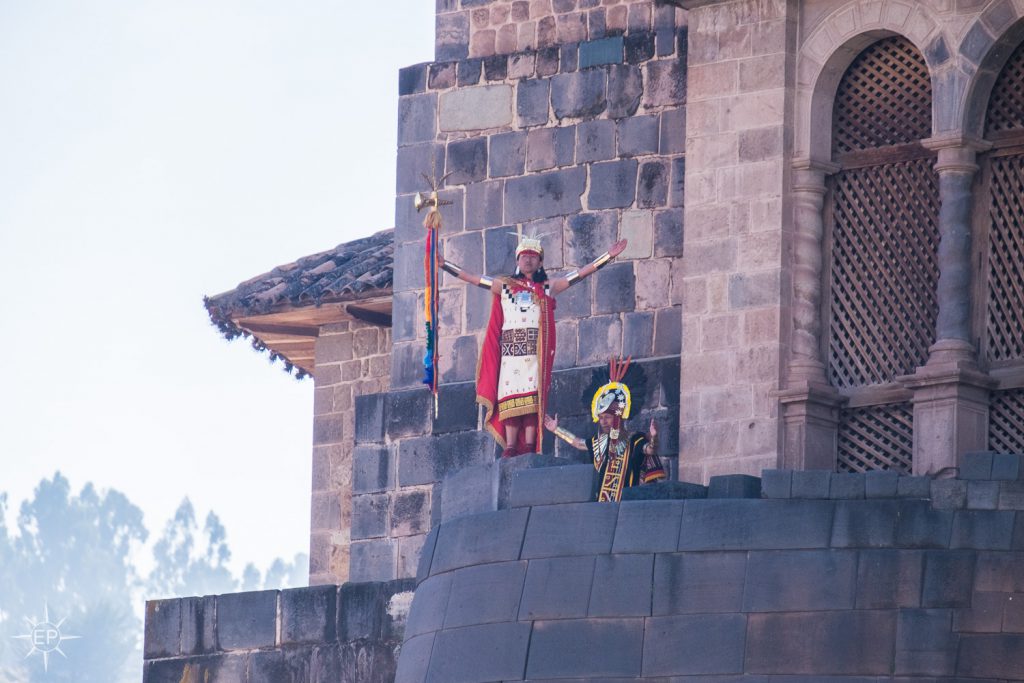
The Sapa Inca emerges at Coricancha. Photo by Everywhere Please.
Fortunately for the Inca’s bearers, the modern litter is a mere replica of the original, solid gold chariot.
A group of some 100 musicians announce the Inca’s arrival on pututos (seashall horns).
Women sweep away evil spirits using the branches of the Andean cedroncillo plant.
Some thirty Nustakunas (chosen women) scatter yellow flowers, while another group of women join the procession carrying baskets of fruit, vegetables and golden idols.
Once in the Plaza de Armas, the Sapa Inca blesses the crowd.
Sacsayhuaman – the Inca fortress above Cusco
The noble procession continues to the Sacsayhuaman fortress while colourful dancers perform for the people.
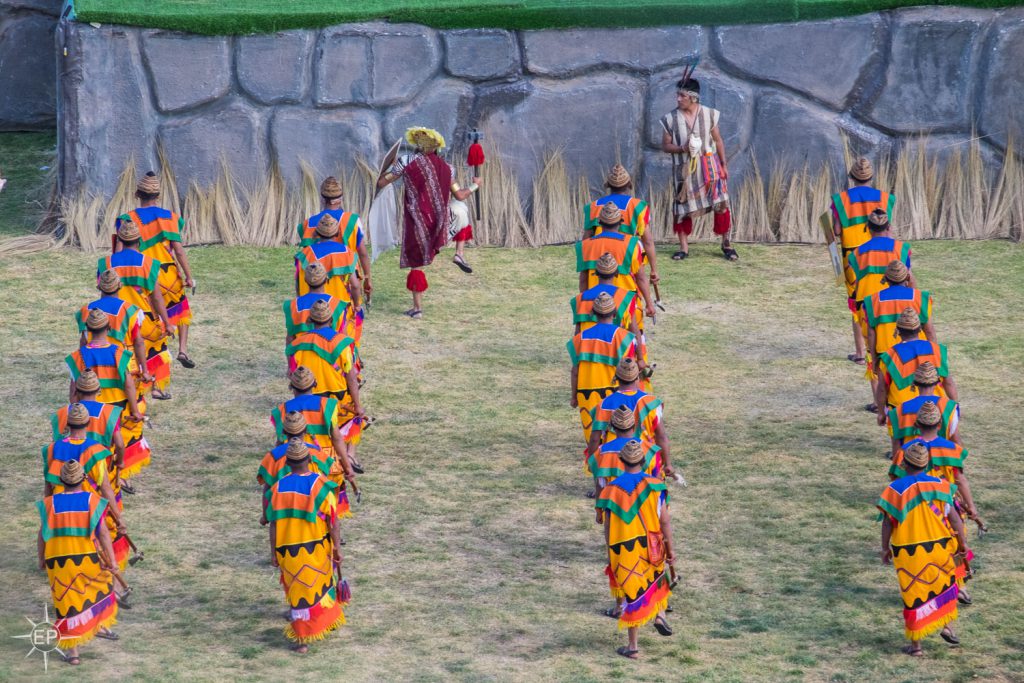
Colorful performers at Sacsayhuaman. Photo by Everywhere Please.
The Sacsayhuaman ruins are packed with those visitors who have managed to get hold of event tickets, whilst thousands more climb the hills and mountains around the ancient fortress to catch a glimpse of the Sapa Inca.
The Inca and selected nobles ascend to the ushnu (alter) give speeches in Quechua, paying homage to the Sun.
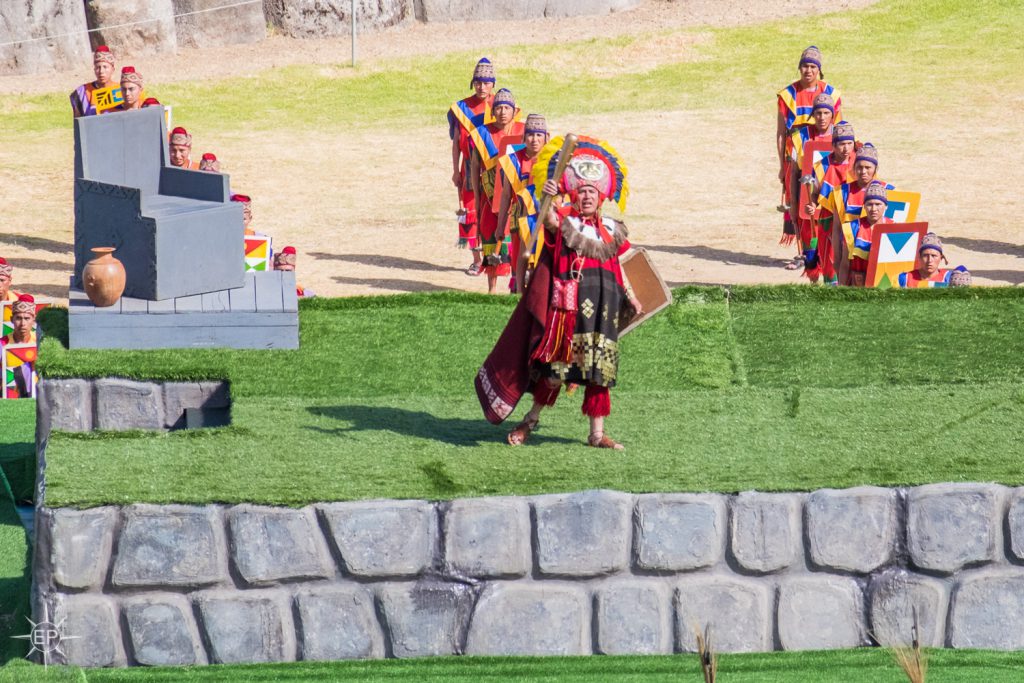
The Sapa Inca on the altar at Sacsayhuaman. Photo by Everywhere Please.
The climax of the celebration is the convincing (but entirely faked!) sacrifice of the black llama.
This is followed by the reading of the animal’s “innards” to predict the fortunes of the empire.
The ceremony ends as Inti’s light begins to sink below the horizon.
The Sapa Inca and his court proceed back to Cusco, making way for troupes of dancers and musicians.
Inti Raymi and Machu Picchu
The winter solstice is the most special time of the year to visit Machu Picchu.
Since Inti Raymi falls on June 24, you can combine the festival with Machu Picchu on June 21.
Let us know as far in advance as possible if you would like to take advantage of this once-in-a-lifetime opportunity.
A visit to the awe-inspiring Inca citadel of Machu Picchu is a humbling and life-changing experience whenever you visit, but a visit on June 21 is truly magical.
The construction of the Temple of the Sun in Machu Picchu is such that at sunrise on the winter solstice, the sun enters through the central window and falls directly on the large ceremonial stone.
The Incas’ knowledge of the heavens and architectural genius are sure to leave you blown away!
Choose your best option for the Inca Trail
There are a number of options for hiking the Inca trail.
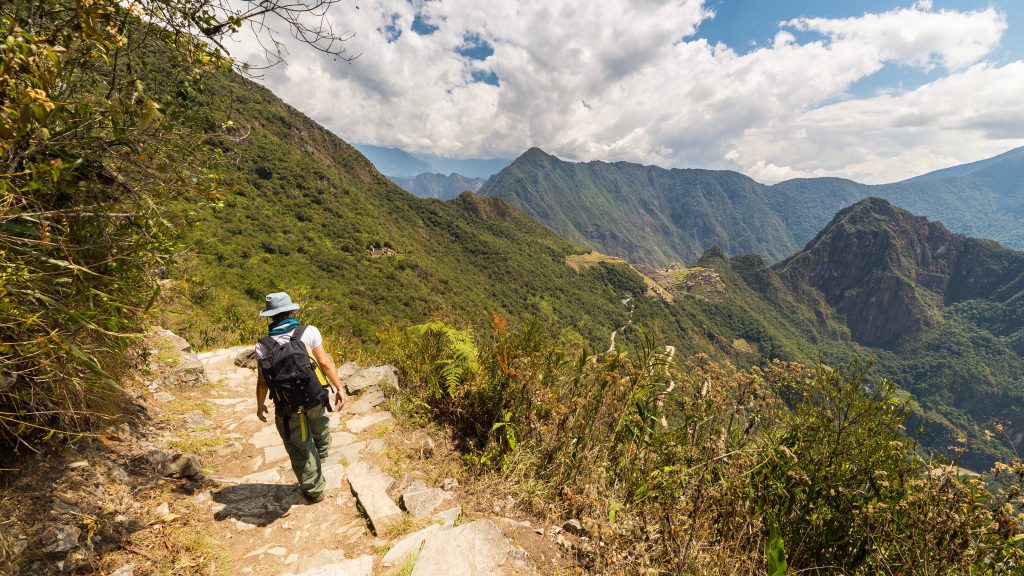
A great time to hike the Inca Trail is during the winter solstice.
The classic four-day trek begins at km82, just outside the ancient Inca town of Ollantytambo.
During the course of the four days, you will hike over mountains, through settlements and past majestic Inca ruins, all the while enjoying the very best scenery that the Sacred Valley has to offer.
The four-day trek is a wonderful opportunity to detach yourself from the modern world and really immerse yourself in nature.
You will enjoy the Inca trail in its original sense, as a pilgrimage.
Another popular option is the two-day trek.
This route starts at km104, and continues along the classic Inca trail.
You will finish with the world-famous view of Machu Picchu through the Sun Gate.
You’ll spend the night in a hotel in Aguas Calientes, and then get up bright and early the next day in time for the winter solstice sunrise at the Sun Temple!
Useful tips for Inti Raymi Festival
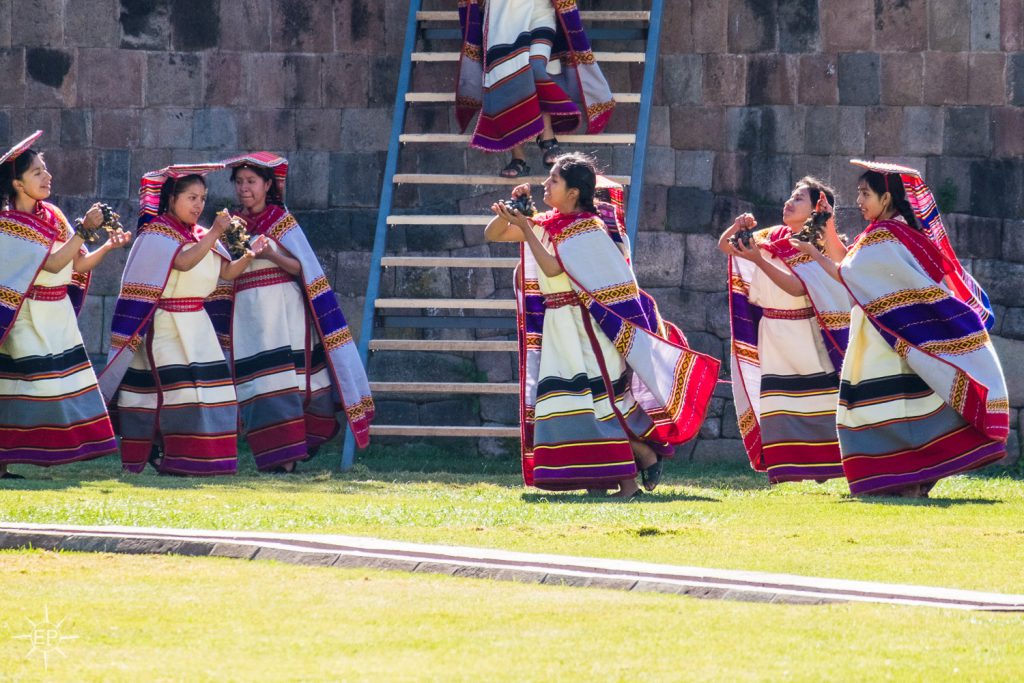
Dancers at Coricancha during Inti Raymi festival in Cusco. Photo by Everywhere Please.
Seating at the Cusco Festival of the Sun
The best way to watch Inti Raymi, the Cusco festival of the sun, is from one of the grandstand seats in Sacsayhuaman, but be sure to book well in advance!
Festival packages are available for all budgets, from front-row seats to a reserved chair on the nearby hillside. Contact us for further information about price brackets and availability.
For those on a budget, it’s entirely possible to view the festivities without tickets, albeit from a much greater distance.
Qoricancha is standing room only. The celebrations take place in the temple gardens, and locals arrive in the early morning to grab the best spots. Crowds in the colonial arcades around Plaza de Armas can reach four or five rows deep! Therefore, the best vantage points are the balconies around the plaza. Reserve your spot by talking to the bar and café owners a few days beforehand.
The most popular place for locals to watch Inti Raymi is from the two hills that overlook Sacsayhuaman. Although the main ruins remain closed on June 24, entrance to the hills is free to all visitors. Be aware that the crowds start to build as early as 8am!
Accommodation
Cusco fills to bursting point around June 24.
So whether you are planning to see the festivities or not, it is recommended to book accommodation early.
Getting around during Inti Raymi
The entire city centre of Cusco remains closed to traffic on June 24.
This includes local buses and taxis; only approved tourist vehicles are allowed to circulate, transporting tourists from Cusco to Sacsayhuaman.
Please be aware of this if you need to make arrangements to get into or out of Cusco.
Alternatives to Inti Raymi Festival or Cusco festival of The Sun
If you can’t make it to Cusco for June 24, don’t despair!
You can see folk dances and performers in traditional Inca costume in the Plaza de Armas at any point in the two weeks leading up to the festival.
In fact, there are some visitors who prefer the spontaneity of the local celebrations!
Like it? Pin it!



